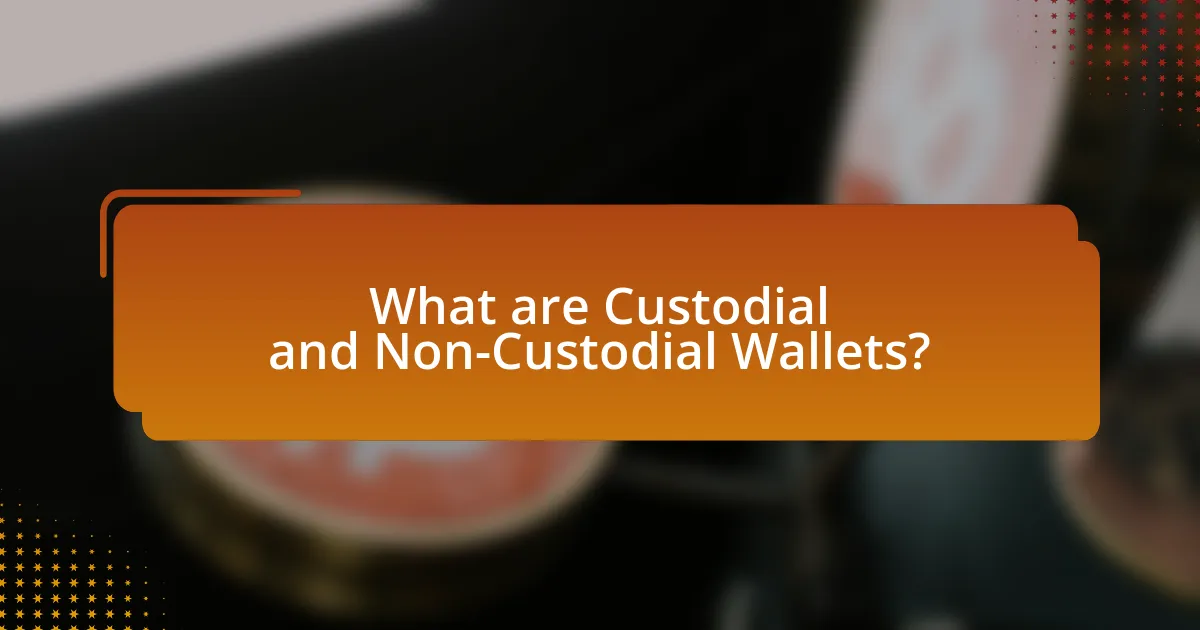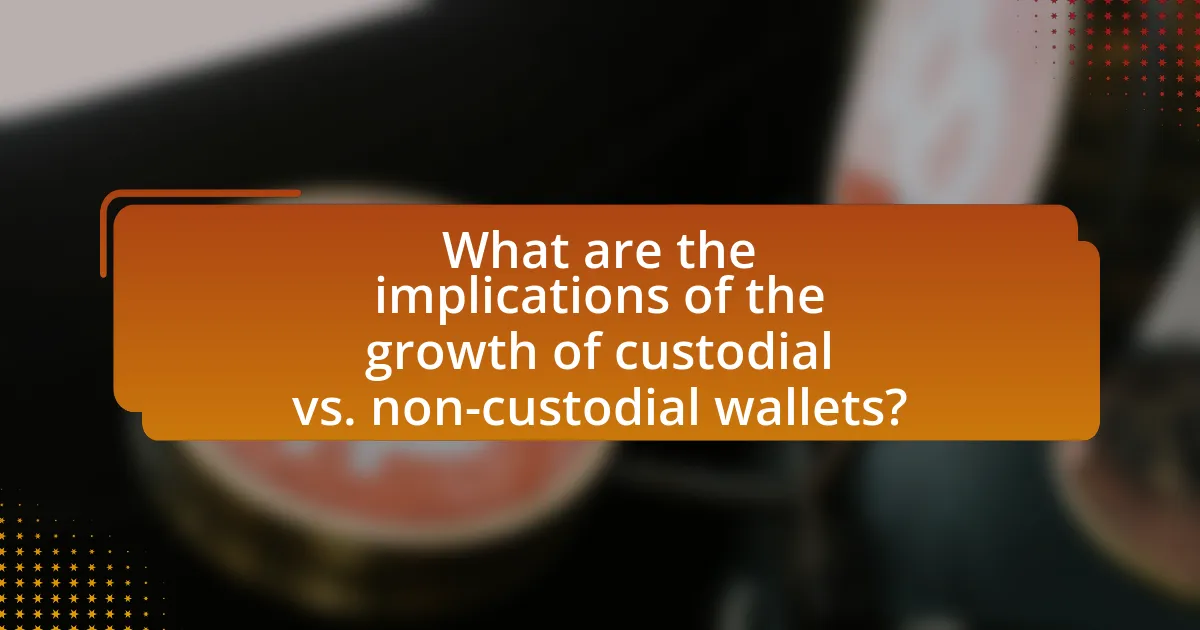The article analyzes the growth of custodial and non-custodial wallets, two distinct types of digital wallets used for managing cryptocurrency. Custodial wallets are managed by third parties, offering user-friendly interfaces and integrated trading features, but come with risks related to trust and security. In contrast, non-custodial wallets provide users with full control over their private keys and funds, enhancing security and privacy, though they require a greater understanding of key management. The article discusses the factors driving the adoption of both wallet types, their implications for the cryptocurrency market, and best practices for users when selecting a wallet.

What are Custodial and Non-Custodial Wallets?
Custodial wallets are digital wallets where a third party manages the private keys and funds on behalf of the user, while non-custodial wallets allow users to control their private keys and funds directly. The distinction is significant because custodial wallets, often provided by exchanges, simplify access and usability but introduce risks related to trust and security, as users must rely on the provider to safeguard their assets. In contrast, non-custodial wallets enhance security and privacy since users retain full control, but they require a greater understanding of managing private keys and the associated risks of loss. This differentiation is crucial in the context of the growing adoption of cryptocurrencies, as users weigh convenience against security.
How do custodial wallets function?
Custodial wallets function by allowing a third-party service to hold and manage the private keys associated with a user’s cryptocurrency. This means that users do not have direct control over their funds; instead, they rely on the custodian to secure and facilitate transactions on their behalf. For example, popular exchanges like Coinbase and Binance operate custodial wallets, where they maintain the security of users’ assets while providing features such as trading and easy access to funds. This model simplifies the user experience but introduces risks related to trust and security, as users must depend on the custodian’s practices and infrastructure to protect their assets.
What are the key features of custodial wallets?
Custodial wallets are digital wallets where a third party manages the private keys on behalf of the user. Key features include user-friendly interfaces that simplify cryptocurrency transactions, enhanced security measures such as multi-signature authentication and cold storage, and customer support services that assist users with issues. Additionally, custodial wallets often provide integrated trading platforms, allowing users to buy, sell, and exchange cryptocurrencies directly within the wallet. According to a report by Chainalysis, custodial wallets accounted for over 70% of all cryptocurrency transactions in 2021, highlighting their popularity and trust among users.
What security measures are in place for custodial wallets?
Custodial wallets implement several security measures to protect users’ funds, including multi-signature authentication, cold storage, and regular security audits. Multi-signature authentication requires multiple private keys to authorize transactions, enhancing security against unauthorized access. Cold storage involves keeping the majority of funds offline, reducing exposure to online threats. Regular security audits by third-party firms help identify vulnerabilities and ensure compliance with industry standards, thereby reinforcing the overall security framework of custodial wallets.
How do non-custodial wallets operate?
Non-custodial wallets operate by allowing users to maintain control over their private keys, which are essential for accessing and managing their cryptocurrency assets. In this model, the wallet software generates a unique pair of cryptographic keys: a public key for receiving funds and a private key for signing transactions. Users are responsible for securely storing their private keys, ensuring that only they can authorize transactions. This decentralized approach enhances security and privacy, as no third party has access to the user’s funds or transaction history. According to a report by Chainalysis, non-custodial wallets have seen significant adoption due to their ability to provide users with greater autonomy and reduced reliance on centralized exchanges.
What are the main characteristics of non-custodial wallets?
Non-custodial wallets are characterized by user control over private keys, enhanced security, and increased privacy. Users maintain sole ownership of their private keys, which means they have full control over their funds without relying on third-party services. This autonomy reduces the risk of hacks associated with centralized exchanges, as funds are stored directly on the user’s device. Additionally, non-custodial wallets often provide greater privacy since transactions do not require personal information, allowing users to operate with anonymity. These features contribute to the growing preference for non-custodial wallets among cryptocurrency users seeking security and independence.
What security protocols do non-custodial wallets utilize?
Non-custodial wallets utilize several security protocols, including private key management, seed phrases, and encryption. Private key management ensures that users have sole control over their keys, which are stored locally rather than on a centralized server, reducing the risk of hacks. Seed phrases, typically a series of 12 to 24 words, allow users to recover their wallets securely, providing an additional layer of protection. Encryption protocols safeguard the wallet data, ensuring that even if the device is compromised, the information remains secure. These protocols collectively enhance the security of non-custodial wallets, making them a preferred choice for users prioritizing control and privacy in their cryptocurrency transactions.

What factors are driving the growth of custodial and non-custodial wallets?
The growth of custodial and non-custodial wallets is driven by increasing demand for cryptocurrency adoption and enhanced security features. As more individuals and businesses engage with cryptocurrencies, the need for secure storage solutions has surged. Custodial wallets, managed by third parties, attract users seeking convenience and ease of access, while non-custodial wallets appeal to those prioritizing control over their private keys and funds. Additionally, advancements in technology, such as improved user interfaces and multi-signature capabilities, have made both types of wallets more user-friendly and secure. According to a report by Statista, the number of blockchain wallet users worldwide reached over 80 million in 2021, highlighting the growing interest in digital asset management.
Why is there an increasing demand for custodial wallets?
The increasing demand for custodial wallets is primarily driven by their user-friendly nature and enhanced security features. Many users, especially those new to cryptocurrency, prefer custodial wallets because they simplify the management of digital assets by handling private keys and transactions on behalf of the user. This convenience is supported by the fact that custodial wallets often provide additional security measures, such as insurance against hacks and user-friendly recovery options, which appeal to individuals who may lack technical expertise. Furthermore, as the cryptocurrency market matures, more institutional investors are entering, leading to a greater reliance on custodial solutions that offer compliance and regulatory support.
What user demographics are favoring custodial wallets?
Younger users, particularly those aged 18 to 34, are favoring custodial wallets due to their user-friendly interfaces and ease of access. This demographic often prioritizes convenience and security, making custodial wallets appealing as they manage private keys and provide customer support. Additionally, research indicates that individuals with lower technical expertise are more likely to choose custodial wallets, as they reduce the complexity associated with managing cryptocurrencies. According to a survey by Statista in 2022, approximately 60% of users in this age group reported using custodial wallets for their cryptocurrency transactions, highlighting a significant trend among younger demographics.
How do custodial wallets enhance user experience?
Custodial wallets enhance user experience by providing simplified access and management of digital assets. These wallets handle private keys on behalf of users, reducing the complexity associated with key management and security. This user-friendly approach allows individuals, especially those new to cryptocurrency, to engage with digital assets without needing extensive technical knowledge. Furthermore, custodial wallets often offer additional features such as customer support, recovery options, and integrated trading services, which contribute to a more seamless and secure experience.
What is contributing to the rise of non-custodial wallets?
The rise of non-custodial wallets is primarily driven by increasing user demand for privacy and control over personal assets. Users prefer non-custodial wallets because they allow individuals to retain full ownership of their private keys, reducing reliance on third-party services that could be vulnerable to hacks or mismanagement. Additionally, the growing awareness of security risks associated with custodial wallets, highlighted by high-profile breaches in the cryptocurrency space, has further fueled this trend. According to a report by Chainalysis, the total value of assets held in non-custodial wallets has surged, reflecting a shift in user preferences towards self-custody solutions.
What advantages do non-custodial wallets offer over custodial options?
Non-custodial wallets provide users with greater control over their private keys and funds compared to custodial options. This autonomy reduces the risk of hacks or mismanagement by third parties, as users are solely responsible for their assets. Additionally, non-custodial wallets enhance privacy since transactions do not require personal information to be shared with a custodian. According to a report by Chainalysis, non-custodial wallets have seen significant adoption, indicating a growing preference for user sovereignty in managing digital assets.
How is the perception of security influencing non-custodial wallet adoption?
The perception of security significantly influences non-custodial wallet adoption by instilling trust in users regarding the safety of their assets. Users often view non-custodial wallets as more secure because they allow individuals to retain control over their private keys, reducing the risk of hacks associated with centralized exchanges. According to a survey by the Cambridge Centre for Alternative Finance, 40% of cryptocurrency users prefer non-custodial wallets due to concerns about the security of custodial services. This perception drives adoption as users seek to mitigate risks associated with third-party management of their funds.

What are the implications of the growth of custodial vs. non-custodial wallets?
The growth of custodial wallets implies increased convenience and user adoption, while non-custodial wallets emphasize user control and security. Custodial wallets, managed by third parties, simplify access to cryptocurrencies, attracting users unfamiliar with blockchain technology; for instance, platforms like Coinbase report millions of users due to this ease of use. Conversely, non-custodial wallets empower users with full control over their private keys, enhancing security against hacks that often target custodial services, as evidenced by the $40 million hack of Bitfinex in 2016. This dual growth reflects a broader trend in the cryptocurrency ecosystem, where user preferences are shaping the balance between convenience and security.
How does the growth of these wallets affect the cryptocurrency market?
The growth of custodial and non-custodial wallets significantly impacts the cryptocurrency market by increasing user adoption and liquidity. As more individuals and institutions utilize these wallets, the overall accessibility of cryptocurrencies improves, leading to higher transaction volumes and market participation. For instance, a report by Chainalysis in 2021 indicated that the number of active cryptocurrency wallets grew by over 40% year-on-year, correlating with a surge in market capitalization, which reached approximately $2 trillion during the same period. This growth fosters greater trust and stability in the market, encouraging further investment and innovation within the cryptocurrency ecosystem.
What trends are emerging in the cryptocurrency ecosystem due to wallet growth?
Emerging trends in the cryptocurrency ecosystem due to wallet growth include increased adoption of decentralized finance (DeFi) applications and a shift towards enhanced security measures. As the number of users utilizing both custodial and non-custodial wallets rises, DeFi platforms are experiencing greater user engagement, with total value locked in DeFi exceeding $80 billion in 2021, indicating a strong interest in decentralized financial services. Additionally, the growth of wallets has prompted a focus on security innovations, such as multi-signature wallets and hardware wallets, to protect assets, as evidenced by a 300% increase in hardware wallet sales in 2020. These trends highlight the evolving landscape of cryptocurrency usage and the importance of security and accessibility in wallet technology.
How are regulatory frameworks adapting to the rise of these wallets?
Regulatory frameworks are adapting to the rise of digital wallets by implementing clearer guidelines and compliance requirements for both custodial and non-custodial wallet providers. For instance, jurisdictions like the European Union have introduced the Markets in Crypto-Assets (MiCA) regulation, which aims to create a comprehensive regulatory framework that addresses the unique challenges posed by these wallets, including consumer protection and anti-money laundering measures. Additionally, countries such as the United States are enhancing their regulatory oversight through agencies like the Financial Crimes Enforcement Network (FinCEN), which requires wallet providers to register and comply with existing financial regulations. These adaptations reflect a growing recognition of the need to balance innovation in digital finance with the protection of users and the integrity of financial systems.
What best practices should users follow when choosing between custodial and non-custodial wallets?
Users should assess their security needs, control preferences, and transaction frequency when choosing between custodial and non-custodial wallets. Custodial wallets, managed by third parties, offer convenience and user support, making them suitable for beginners or those who prioritize ease of use. In contrast, non-custodial wallets provide users with full control over their private keys, enhancing security but requiring a higher level of technical knowledge and responsibility.
Additionally, users should consider the reputation and security measures of custodial services, as breaches can lead to loss of funds. According to a report by Chainalysis, custodial wallets accounted for 80% of all cryptocurrency transactions in 2021, highlighting their popularity but also the risks associated with centralized control. Ultimately, the choice depends on individual risk tolerance and the importance of control versus convenience.
What factors should be considered when selecting a wallet type?
When selecting a wallet type, factors such as security, control over private keys, user experience, and compatibility with cryptocurrencies should be considered. Security is paramount, as custodial wallets may expose users to risks associated with third-party management, while non-custodial wallets provide greater control over assets. Control over private keys is crucial; non-custodial wallets allow users to manage their keys directly, reducing reliance on external entities. User experience varies significantly; custodial wallets often offer simpler interfaces, while non-custodial wallets may require more technical knowledge. Lastly, compatibility with various cryptocurrencies is essential, as some wallets support a limited range of assets, impacting the user’s ability to manage their portfolio effectively.
How can users ensure the security of their chosen wallet?
Users can ensure the security of their chosen wallet by implementing strong security practices such as enabling two-factor authentication, using hardware wallets for storing private keys, and regularly updating wallet software. Two-factor authentication adds an extra layer of protection by requiring a second form of verification, significantly reducing the risk of unauthorized access. Hardware wallets, which store private keys offline, are less vulnerable to online attacks compared to software wallets. Regular software updates are crucial as they often include security patches that protect against newly discovered vulnerabilities. These practices collectively enhance wallet security and help safeguard users’ digital assets.


